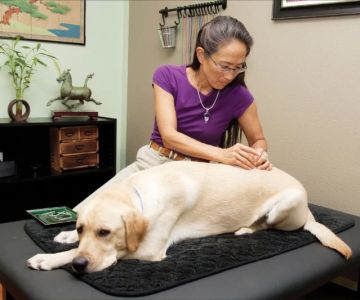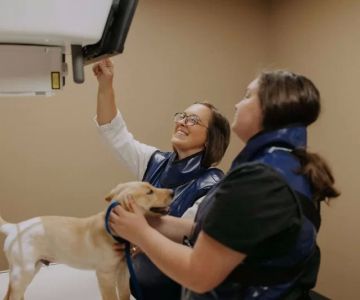Can Any Veterinarian Do Canine Hydrotherapy? A Comprehensive Guide
Canine hydrotherapy is an emerging field that has gained popularity for its therapeutic benefits for dogs, particularly those recovering from injury or surgery. As a passionate advocate for animal well-being, I’ve often wondered, "Can any veterinarian do canine hydrotherapy?" The short answer is no, but it’s a question that many pet owners and aspiring veterinary professionals have. In this article, I’ll dive into the qualifications required for veterinarians to perform canine hydrotherapy, the benefits of this practice, and why it’s not something every veterinarian automatically has the ability to do.
- What Qualifications Does a Veterinarian Need for Canine Hydrotherapy?
- Benefits of Canine Hydrotherapy for Your Dog
- What Type of Training Is Required to Practice Canine Hydrotherapy?
- Real-World Example: A Veterinarian’s Journey into Hydrotherapy
- Alternatives to Canine Hydrotherapy: Other Treatments for Your Pet
What Qualifications Does a Veterinarian Need for Canine Hydrotherapy?
Veterinarians are trained to diagnose and treat a wide variety of medical issues in animals, but hydrotherapy is a specialized field that requires additional expertise. In general, any veterinarian can recommend hydrotherapy as part of a treatment plan for a dog, but only those with specialized training are qualified to administer it. Canine hydrotherapy typically involves using water-based exercises to promote healing and rehabilitation, which can require specific knowledge of biomechanics, therapeutic techniques, and animal behavior.
Veterinarians who wish to perform hydrotherapy typically need certification or training from accredited hydrotherapy organizations. These programs teach the appropriate exercises, techniques, and safety precautions needed to safely carry out hydrotherapy sessions. Veterinarians can pursue this additional training after completing their veterinary degree, and it can take several months to gain the necessary skills. Without this specialized training, a veterinarian would not be qualified to conduct hydrotherapy sessions effectively or safely.
Benefits of Canine Hydrotherapy for Your Dog
Canine hydrotherapy has become a popular and effective form of rehabilitation, especially for dogs recovering from surgery, injury, or those with chronic conditions like arthritis. As I’ve seen in my practice, the benefits of hydrotherapy are extensive. For instance, water therapy provides a low-impact exercise that allows dogs to regain strength, improve mobility, and reduce pain without putting unnecessary strain on their joints.
Water’s buoyancy reduces the stress on a dog’s body, making it an ideal option for dogs with joint problems, spinal issues, or muscle atrophy. Hydrotherapy can also improve circulation and enhance cardiovascular health. For older dogs suffering from mobility issues, hydrotherapy can make a huge difference in their quality of life. I’ve worked with numerous dogs who have shown significant improvements in their ability to walk, run, and jump after a few hydrotherapy sessions.
What Type of Training Is Required to Practice Canine Hydrotherapy?
As mentioned earlier, not every veterinarian is automatically qualified to perform canine hydrotherapy. To gain the proper training, a veterinarian must complete a certification program in animal rehabilitation or hydrotherapy. These programs are typically offered through veterinary schools or specialized institutions and are designed to provide in-depth knowledge of the various therapeutic techniques used in hydrotherapy. The training focuses on aspects such as:
- Understanding the biomechanics of water-based exercises – Proper technique is essential to avoid injury and ensure the therapy is effective.
- Behavioral training – Hydotherapy often involves working with dogs who may be nervous or scared of water, so learning how to manage their anxiety is crucial.
- Equipment handling – From underwater treadmills to swimming pools, veterinarians need to learn how to use the various types of equipment used in hydrotherapy.
- Clinical rehabilitation techniques – Veterinarians must understand the healing process and how to tailor the hydrotherapy sessions to the individual needs of each dog.
Many programs also require hands-on experience with animals under supervision to ensure veterinarians are ready to manage real-world cases. This specialized training is vital for veterinarians who want to incorporate hydrotherapy into their practice.
Real-World Example: A Veterinarian’s Journey into Hydrotherapy
Let me share a story about Dr. Susan, a veterinarian who decided to specialize in canine hydrotherapy after realizing the significant benefits it had for her patients. Dr. Susan had been practicing general veterinary medicine for years when she began noticing an increasing number of dogs with mobility issues coming into her clinic. After attending a seminar on hydrotherapy and seeing the results firsthand, she decided to pursue certification in animal rehabilitation.
Upon completing her training, Dr. Susan introduced hydrotherapy sessions into her practice. One case that stands out is of a Golden Retriever named Max, who had undergone surgery for hip dysplasia. Max’s owner was concerned that Max might never regain full mobility. After just a few weeks of hydrotherapy, Max’s movement improved drastically—he regained strength in his hind legs and was able to walk with less pain. This success story inspired Dr. Susan to continue providing hydrotherapy as a therapeutic option for her patients.
This real-world example highlights how hydrotherapy can make a significant difference in a dog’s recovery process and quality of life, especially when administered by a well-trained veterinarian.
Alternatives to Canine Hydrotherapy: Other Treatments for Your Pet
While hydrotherapy is incredibly effective, it is not the only form of rehabilitation available for dogs. Depending on the condition, there are various other therapeutic options to consider. For example, physical therapy, acupuncture, and massage therapy are often used in conjunction with hydrotherapy to enhance the healing process.
Additionally, some dogs may benefit from medications or surgical interventions to address more severe conditions. A well-rounded treatment plan tailored to your dog’s specific needs is crucial for ensuring the best possible outcome. As a veterinarian, I always work with pet owners to explore all the options available and determine what would work best for their pet’s health and well-being.











